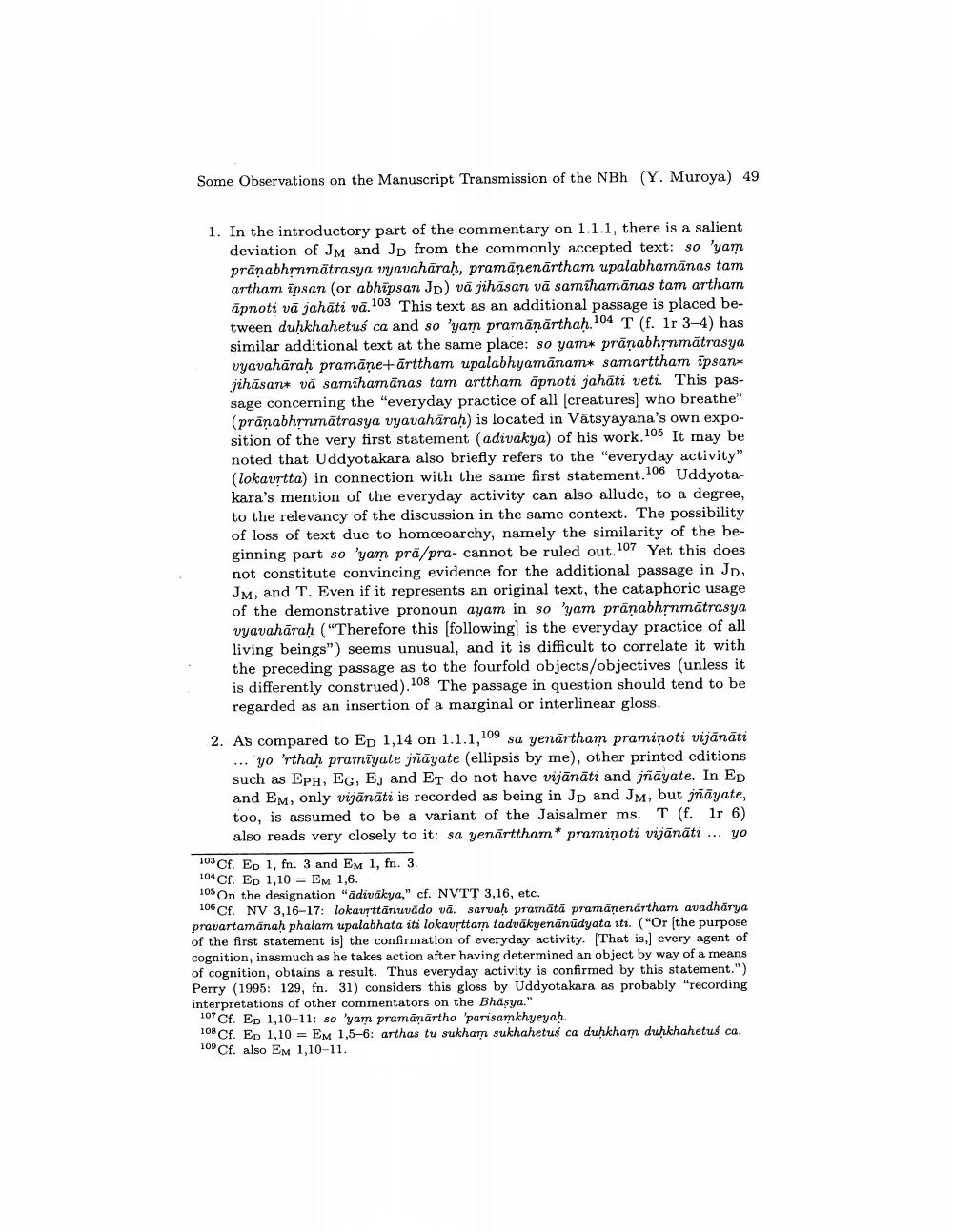________________
Some Observations on the Manuscript Transmission of the NBh (Y. Muroya) 49
1. In the introductory part of the commentary on 1.1.1, there is a salient
deviation of JM and JD from the commonly accepted text: so 'yam prānabhrmātrasya vyavahāraḥ, pramāņenārtham upalabhamānas tam artham īpsan (or abhipsan JD) va jihāsan vā samīhamānas tam artham āpnoti vā jahāti vā. 103 This text as an additional passage is placed between duḥkhahetuś ca and so 'yam pramānārthah.104 T (f. 1r 3-4) has similar additional text at the same place: so yam* prāṇabhnmātrasya vyavahārah pramāne+ārttham upalabhyamānam* samarttham ipsan* jihāsan* vă samihamānas tam arttham āpnoti jahāti veti. This passage concerning the "everyday practice of all (creatures) who breathe" (prānabhrnmätrasya vyavahärah) is located in Vātsyāyana's own exposition of the very first statement (ādivākya) of his work.106 It may be noted that Uddyotakara also briefly refers to the "everyday activity" (lokaurtta) in connection with the same first statement.100 Uddyotakara's mention of the everyday activity can also allude, to a degree, to the relevancy of the discussion in the same context. The possibility of loss of text due to homoeoarchy, namely the similarity of the beginning part so 'yam prä/pra- cannot be ruled out.107 Yet this does not constitute convincing evidence for the additional passage in JD, JM, and T. Even if it represents an original text, the cataphoric usage of the demonstrative pronoun ayam in so 'yam prānabhrmātrasya vyavahārah ("Therefore this (followingl is the everyday practice of all living beings") seems unusual, and it is difficult to correlate it with the preceding passage as to the fourfold objects/objectives (unless it is differently construed).108 The passage in question should tend to be regarded as an insertion of a marginal or interlinear gloss.
2. As compared to Ep 1,14 on 1.1.1,109 sa yenārtham praminoti vijānāti
... yo 'rthah pramīyate jñāyate (ellipsis by me), other printed editions such as Eph, EG, EJ and Et do not have vijānāti and jñāyate. In ED and Em, only vijānāti is recorded as being in Jp and JM, but jñāyate, too, is assumed to be a variant of the Jaisalmer ms. T (f. 1r 6) also reads very closely to it: sa yenārttham* pramiņoti vijānāti ... yo
103 Cf. Ep 1, fn. 3 and EM 1, fn. 3. 104 Cf. Ep 1,10 = EM 1,6. 108 On the designation "ādiväkya," cf. NVTT 3,16, etc. 106 Cf. NV 3,16-17: lokavyttänuvädo vā. sarvah pramätā pramāņenartham avadhārya pravartamanah phalam upalabhata iti lokavsttam tadvākyenānūdyata iti. ("Or (the purpose of the first statement is the confirmation of everyday activity. That is,) every agent of cognition, inasmuch as he takes action after having determined an object by way of a means of cognition, obtains a result. Thus everyday activity is confirmed by this statement.") Perry (1995: 129, fn. 31) considers this gloss by Uddyotakara as probably "recording interpretations of other commentators on the Bhasya."
107 Cf. Ep 1,10-11: so 'yam pramanartho 'parisamkhyeyah. 108 Cf. Ep 1,10 = EM 1,5-6: arthas tu sukham sukhahetus ca duhkham dunkhahetus ca. 109 Cf. also Em 1,10-11.




